
New cars hit the track for what could be closest season yet
Inside the world of modern motorsport technology




New cars hit the track for what could be closest season yet


Pure V12 sound returns to endurance racing with iconic British marque
Why a machine learning world still needs the human factor




FIA’s ambitious plan to boost entry numbers in 2027

SEWAGE POWER
Waste-derived hydrogen fuels UK university racecar



500
The ne art of preparing for NASCAR’s biggest race


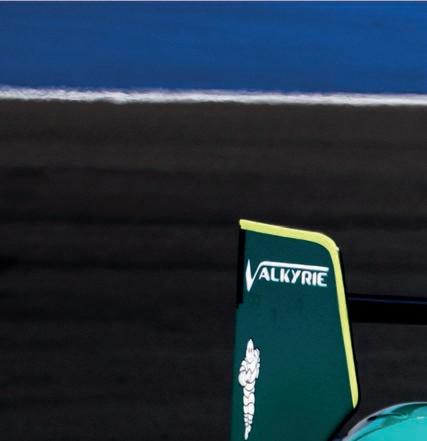



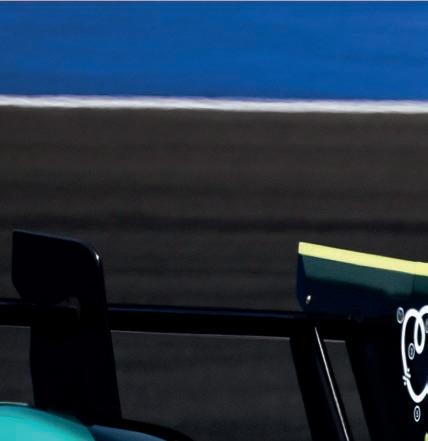





Aston Martin’s new LMH car made its competition debut at the opening round of the WEC in Qatar. Racecar was there to track its progress
By ANDREW COTTON






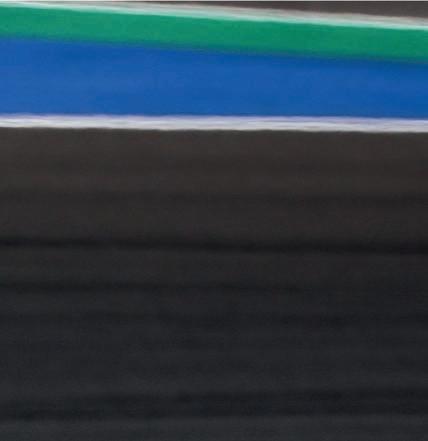
Aston Martin is the first LMH manufacturer to meet the criteria of both the WEC and the IMSA Sportscar Championship


Its name is steeped in Norse mythology. The Valkyries were believed to decide who should live and who should die on the battle eld. They were also beings that transported the fallen to Valhalla, where warriors would ght during the day and feast all night. Perhaps appropriate, then, that Aston Martin’s Valkyrie should carry the name forward into the 24 Hours of Le Mans. Originally scheduled to race for the rst time in January 2025, at the 24 Hours of Daytona, the LMH-spec Valkyrie’s rst

competitive steps were not taken until late February, when two cars made their longawaited debut at the FIA World Endurance Championship season opener in Qatar.
Aston Martin is the third constructor to race a non-hybrid LMH car in the WEC, after Glickenhaus and ByKolles, neither of which is on the grid any longer. It is also the rst mainstream brand to commit to the Hypercar class with a non-hybrid. All other OEMs have either built their own hybrids or developed LMDh cars which use a spec hybrid package.




Crucially, Aston Martin is the rst LMH manufacturer to meet the criteria of both the WEC and the IMSA Sportscar Championship in the United States. The Valkyrie will, therefore, break new ground as the rst LMH to race in IMSA. It will be run there, and in the WEC, by The Heart of Racing, an American team backed by video game developer Gabe Newell, which has elded Aston Martin Vantage GT3s in recent years and also helped to fund the LMH Valkyrie project.

McLaren prevailed in a tight F1 battle last year, and expects the field to again be close in the final season of the current regulations

The final season of an F1 rule set always promises close racing. Racecar assesses the priorities for each team heading into 2025
By DANIEL LLOYD
That the field would close up in the final stages has been the hope since the early days of the latest Formula 1 rules cycle, which arrived in 2022 off the back of a cracker in 2021 and is now approaching its conclusion. After two seasons of Red Bull dominance, patient F1 fans were rewarded with a fierce battle for the constructors’ title last year. McLaren overcame Red Bull to win its first championship in 26 years, while Ferrari also chimed in on the battle. Mercedes won races, too. Between that trio, seven different drivers stood atop the podium in one exciting season.
The 2025 campaign therefore has a lot to live up to, but logic dictates it has a good chance of providing a nail-biting finish the fans, and everyone involved, are hoping for. The usual trend of development in F1 is for designs to funnel down as the regulations mature, homing in on the final year when all teams have more knowledge about their cars than at any other point.
How do you prepare a NASCAR for the Daytona 500? Racecar spent a day with the event’s most successful team to find out
By BOZI TATAREVIC

‘A lot of the decisions on configuration of things… are made from several years of trial and error; kind of brute force working through it in nature’
Cliff Daniels, crew chief at Hendrick Motorsports
The process of assembling a NASCAR Cup Series car has changed in recent years as teams have moved from fabricating their own chassis to using the Dallara-designed, modular Gen 7 platform. Even though they operate in a much smaller box these days, successful teams still find creative ways to make speed.
Racecar sat down with Cliff Daniels, crew chief at Hendrick Motorsports, to find out how the team builds a car to contest the Daytona 500.
Hendrick is the most successful team in Cup Series history, with over 300 wins and 14 drivers’ championships to its credit. It racked

up its record-extending 10th Daytona 500 victory in mid-February with William Byron, so the preparations detailed here were evidently worthwhile.
The process of building a fleet of cars for the first race of the 2025 regular season starts almost immediately after the conclusion of the previous campaign. Less than three months separating the chequered flag at Phoenix from transporters being loaded for Daytona means teams need to work extremely efficiently, so schedules for the car builds are laid out in early December before any holiday season breaks.
Hendrick fielded four cars at Daytona for Byron, Kyle Larson, Chase Elliott and Alex Bowman, so it needed to build four primary cars, along with two back-ups to have available in case of damage during practice.
Upon return from Phoenix, all of the cars that raced were measured using the team’s in-shop version of the Hawk-Eye OSS (optical scanning station). The data was entered into the team’s database, so it could see how components had changed during the race. Cars were also scanned with Hexagon Absolute measuring arms and CMMs (coordinate measuring machines) as they were torn down.

We talk to the people behind the now-delayed TOCA Junior series to nd out what it takes to design and build a racecar for drivers as young as 14
By MIKE BRESLIN / PICTURES: ELIZABETH JAY, BRESMEDIA



The Chevron B1417 has been designed speci cally for 14 to 17-year-old drivers, and the plan is to run it in an all-new TOCA Junior series that will support the wellestablished British Touring Car Championship
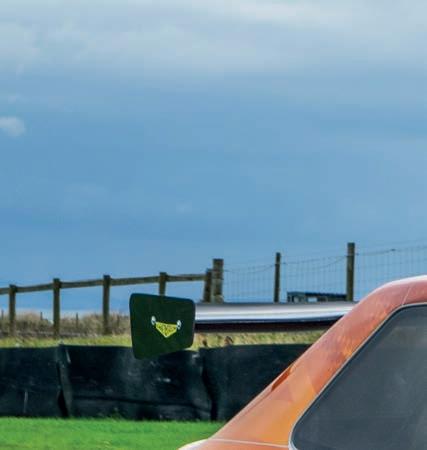
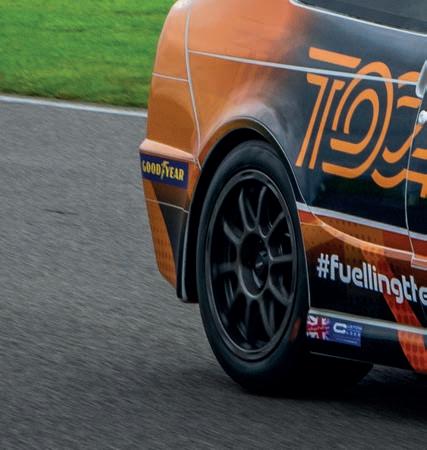






When the TOCA governing body started its search for a replacement for the Ginetta Junior Championship, which left the British Touring Car Championship’s (BTCC) support package two seasons ago, three things stood high on its list of requirements. First, the new series should provide the frantic action that made the Ginettas so popular with spectators. Second, the car should be a recognisable touring car-style shape. Third, it should be designed from the ground up to suit drivers as young as 14 who might become future BTCC stars.
The concept that ful lled this brief best was the Chevron B1417. The ‘B’ is a nod to the traditional naming convention of the revived Chevron marque (see box out on p44), and ‘1417’ denotes the 14-17 age range of drivers classed as Juniors. The series in which the new vehicle will race will be called TOCA Junior.
Dave Beecroft is the man behind both the car and the series. A stalwart of the British racing scene, Beecroft began his motorsport career at the age of 17, having switched from a job in a garage to work as an engineer


in the British Formula 1 Championship with Cobra Motorsport in the early 1980s.
Since then, he has been involved in many categories, including running a Lexus IS200 in the BTCC in the mid-2000s. For the last decade or so, has been mainly overseeing the Junior Saloon Car Championship (JSCC), so has plenty of experience with drivers at the beginning of their careers.
The plan was for the new TOCA Junior to appear on the BTCC race card at all 10 of its 2025 meetings but, late in February, the decision was taken to delay the Junior series until 2026, as take up of the new car was slower than had been anticipated.

‘TOCA has been missing the Juniors,’ says Beecroft. ‘As Alan [Gow, BTCC chief executive] has said, it’s an important part of the package. There’s a lot of talk that TV isn’t the thing any more because it’s all digital, it’s all streaming, but that’s not true. Touring cars on a Sunday afternoon still gets massive viewing gures. The biggest gures are for touring car races, but the next biggest used to be the Juniors.’



While the new TOCA Junior series will almost certainly provide entertaining racing when it gets o the ground – give a teenager a racecar and action is pretty much guaranteed – the car is a very di erent beast to the Ginetta that went before it, or the Citroën Saxo that is raced in JSCC.

‘The Saxo’s great for kids, for learning, but it’s a shopping car trying to be a racing car,’ Beecroft says. ‘This is a proper racecar. We don’t have the compromises you have with a road car trying to be one.’
This means the Chevron B1417 has been designed from the ground up, on a clean sheet of paper, there were still some aspects that came as part of a brief from TOCA: ‘The objective, from Alan’s point of view, was to go rear-wheel drive, because kids come out of junior racing and go straight into F4. There are already front-wheel drive championships for juniors, with the Fiestas [BRSCC Fiesta Junior Championship] and the JSCC cars. When it comes to the packaging of how you build a rear-wheel drive or a front-wheel drive car, it didn’t really make any di erence for us.’



Small, light, nimble, powerful and reliable, this is the extraordinary world of Polaris side-by-side racers as they compete on the most challenging rally of them all
By LAWRENCE BUTCHER
